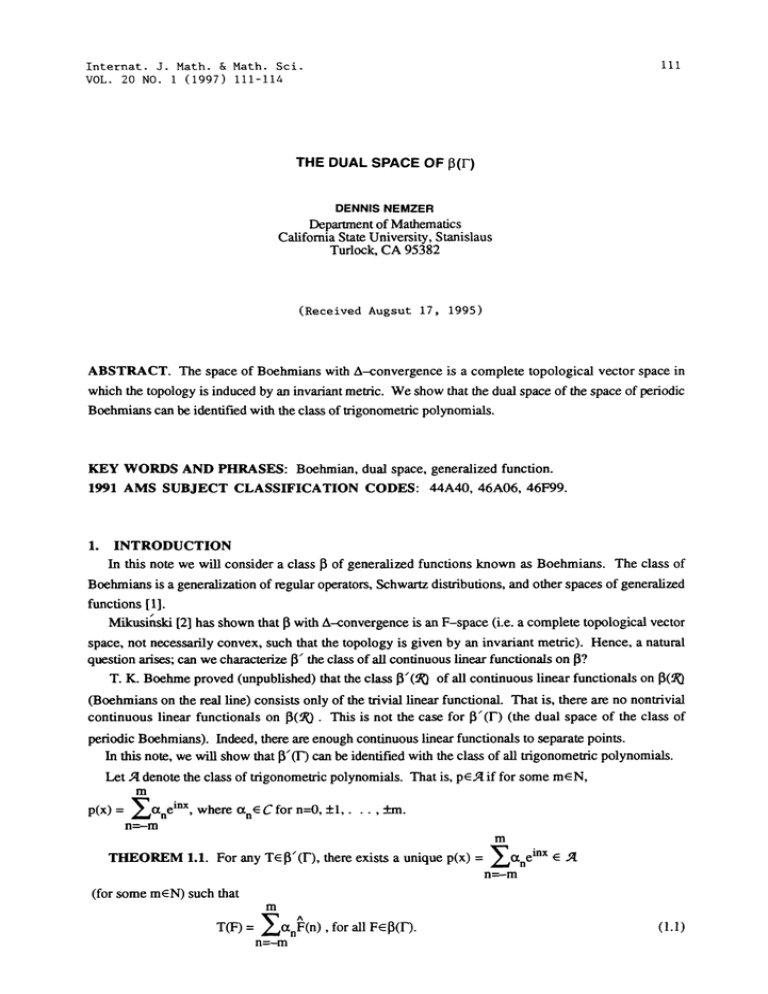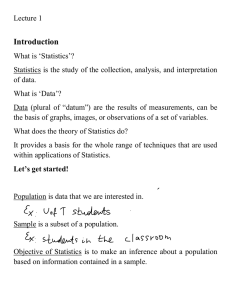Document 10452325
advertisement

iii
Internat. J. Math. & Math. Sci.
(1997) 111-114
VOL. 20 NO.
THE DUAL SPACE OF (F)
DENNIS NEMZER
Department of Mathematics
California State University, Stanislaus
Tudock, CA 95382
(Received Augsut 17, 1995)
ABSTRACT. The space of Boehmians with A-convergence is a complete topological vector space in
which the topology is induced by an invariant metric. We show that the dual space of the space of periodic
Boehmians can be identified with the class of trigonometric polynomials.
KEY WORDS AND PHRASES: Boehmian, dual space, generalized function.
1991 AMS SUBJECT CLASSIFICATION CODES" 44A40, 46A06, 46F99.
1. INTRODUCTION
In this note we will consider a class I of generalized functions known as Boehmians. The class of
Boehmians is a generalization of regular operators, Schwartz distributions, and other spaces of generalized
functions 1].
Mikusinski [2] has shown that I with A-convergence is an F-space (i.e. a complete topological vector
space, not necessarily convex, such that the topology is given by an invariant metric). Hence, a natural
question arises; can we characterize I]" the class of all continuous linear functionals on I?
T. K. Boehme proved (unpublished) that the class I’() of all continuous linear functionals on
(Boehmians on the real line) consists only of the trivial linear functional. That is, there are no nontrivial
continuous linear functionals on I(,0. This is not the case for (1") (the dual space of the class of
I"
periodic Boehmians). Indeed, there are enough continuous linear functionals to separate points.
In this note, we will show that I’(1-’) can be identified with the class of all trigonometric polynomials.
Let denote the class of trigonometric polynomials. That is, pe. if for some meN,
,
m
p(x)
’-
inx where
z._,ttne
n=..-m
tne C for n=0, +1
:ha.
m
TItEOllEN 1.1. For any
Te" (F), there exists a unique p(x)
2ne
mx
s
(for some m e N) such that
m
T(F)
nF(n), for all Fel3(F).
n=-m
(1.1)
D. NEMZER
112
m
tnenx
Conversely, any p(x)
n=-m
.
defines a continuous linear functional on
I(F) via (1.1).
2. PRELIMINARIES
We use the same notation as in [3]. For other results concerning I(F) see [4,5]. In [3] the
construction of I(F) differs from the construction in [4,5], but the space 13(F) in both cases can be shown
to be the same.
The collection of all continuous complex-valued functions on .will be denoted by C(0. The
support of a continuous function f, denoted by supp f, is the complement of the largest open set on which
f is zero.
The convolution of two continuous functions, where at least one has compact support, is given by
dt.
(f*g)(x)
,.
I_,,f(x-t)g(t)
A sequence of continuous nonnegative functions {5n will be called a delta sequence if
(i)
(-n’ n )’ where en-,0 as n--, ,.
A pair of sequences (fn’ Sn) is called a quotient of sequences, and denoted by fn/Sn, if fnC() (n=l,
Sn(X) dx
and (ii) supp 5n c
for n=l, 2
2
for all m and n. Two quotients of sequences fn/Sn
), {in is a delta sequence, and
and gn/tn are equivalent if fn*tm=gm*Sn for all m and n. The equivalence classes are called Boehmians.
fn*im=fm*Sn
The space of all Boehmians will be denoted by (0, and a typical element of 13(0 will be written as F
fl/in. By def’ming a natural addition and scalar multiplication on (), i.e. fn/Sn + gn/tn
(fn*tn + gn*in)/(Sn*tn) and a(fn/Sn) afn/15n, where ot is a complex number, 13(0 becomes a vector
space.
A sequence
Fn F, if there
{Fn} of Boehmians is said to be A--convergent to F, denoted by A- lim
exists a delta sequence {Sn} such that for each n, (Fn F)*SnC(eO and (Fn F)*5n
0 uniformly on
compact sets as n--,,,.
If either f is a periodic function of period 2 or supp f c (-r, n), the n tla Fourier coefficient
is defined as f(n)
(f*i) (n)
f(x)e-inx dx, for n=0, +1, +2
By a simple calculation we see that
2:f(n)(n) for all n.
Let I(F)
That is F
(2n)-1
(n) of f
{FI(10 "F
A- lim
E aneinx’
E aleikx"
n-->** k=-n
denoted by F(n), is F(n)
for some sequence
For FI(F) such that F
{an} of complex numbers}.
E aneinx’
the n th Fourier
coefficient of F,
an-
The proof of the next proposition is straightforward and hence is left to the reader.
If A- lira Fn F, then
PROPOSITION .I. Suppose that FnI(F) for n=l, 2
n--->
lim Fn(k) F(k) for each k.
PROPOSITION 2.2 [3, Lemma 3.5]. Let {nk} be a subsequence of positive integers such that
,.
If {an} is any sequence of complex numbers such that an
k=l
then there is a Boehmian FeI(F) such that F(n) an for all n.
l/n k <
0 for n
nk (k=l, 2
),
DUAL SPACE OF B(F)
i13
The conclusion of Proposition 2.2 is also valid for a subsequence n k of negative integers such that
l/n
k
>-,
k=l
3. PROOF OF THE THEOREM
Suppose that T has the form of (1.1), then clearly T is linear. The continuity of T follows from
Proposition 2.1.
For the other direction, suppose that T is any continuous linear functional on I3(F).
Let F
E aneinx
e 13(F). Then, T(F)
E anT(einx)"
Hence to finish the proof, it suffices to show that for only a finite number of n’s, T(e inx) does not
vanish.
Suppose that this is not the case. Thus, there are infinitely many positive (negative) n’s such that
T(e inx) does not vanish.
Now, pick a subsequence {nk from the above n’s such that nk > 2k, for keN.
Let Xnk
(T(ein))-1, for keN.
By Proposition 2.2, them there exists a GeI3(F) such that ,.,(n k)
otherwise. But this gives T(G)
0tnk for k=l, 2
and zero
^
einx
G(n)T(
Thus, for only a finite number of n’s, T(einx) must not vanish and the proof is complete.
4. SOME CONCLUDING REMARKS
The dual space of I3(F) can be identified with spaces other than the space of trigonometric polynomials,
but these spaces are all isomorphic. For example, we could have identified (F) with the subspace of Cz
I"
of finite sequences.
It is known that (1") with A-convergence is not a Banach space. Can the characterization of 13" (F) in
this paper be used to determine whether or not I(F) is a Frtchet space?
Does the strong convergence in (F) have a nice description in terms of some convergence of
I"
-
trigonometric polynomials?
Let to be a real-valued even funcdon defined on the integers Z such that
o(n)
0 o(0) < to(n+m) < to(n) + m) for all n,meZ and
n=l
<
By using Theorems 3.1 and 3.2 in [5], we obtain the following interesting connection between weak
convergence and A--convergence in 13(1").
COROLLARY 4.1. Suppose that the set of positive integers is partitioned into two disjoint sets
n
litn < oo. Let Fn be a sequence of Boehmians such that the set
n=l
is uniformly bounded. Then a necessary and sufficient condition for the sequence
and sn such that
e-O(Sk)Fn(’’s’) }n=l
{Fn} to be A-convergent to zero is that {Fn} converges weakly to zero.
D. NEMZER
114
Pro"
The space of periodic Beurling distributions
can be identified with a subspace of Boehmians. By
is stronger
using Corollary 4.1 and the results in [6], one can show that the convergence structure in
than the convergence
inherits from 13(F).
Pro
Pro"
ACKNOWLEDGMENT. The author would like to thank the referee for his/her helpful suggestions
and comments.
REFERENCES
[1] MIKUSIlqSKI, P., Boehmians and Generalized Functions, Acta. Math. Hungarica 51(1988),
271-281.
[2] MIKUSIlqSKI, P., Convergence of Boehmians, Japan. J. Math. 9 (1983), 159-179.
[3] NEMZER, D., The Product of a Function and a Boehmian, Colloq. Math. 66 (1993), 49-55.
[4] NEMZER, D., Periodic Boehmians, Internat. J. Math. & Math. Sci. 12 (1989), 685-692.
[5i
NEMZER, D., Periodic Boehmians II, Bull. Austral. Math. Soc. 44 (1991), 271-278.
[6] NEMZER, D., Convolution Quotients of Beuding Type, Math. Japonica 42 (1995), 1-8.







